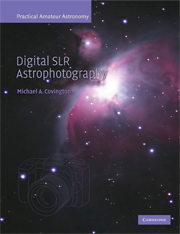3 - Basic camera operation
Published online by Cambridge University Press: 21 August 2009
Summary
In what follows, I'm going to assume that you have learned how to use your DSLR for daytime photography and that you have its instruction manual handy. No two cameras work exactly alike. Most DSLRs have enough in common that I can guide you through the key points of how to use them, but you should be on the lookout for exceptions.
Taking a picture manually
Shutter speed and aperture
To take a picture with full manual control, turn the camera's mode dial to M (Figure 3.2). Set the shutter speed with the thumbwheel.
To set the aperture, some cameras have a second thumbwheel, and others have you turn the one and only thumbwheel while holding down the +/− button. Note that on Canon lenses there is no aperture ring on the lens; you can only set the aperture by electronic control from within the camera. Most Nikon lenses have an aperture ring, for compatibility with older manual cameras, but with a DSLR, you should set the aperture ring on the lens to the smallest stop (highest number) and control the aperture electronically.
Naturally, if there is no lens attached, or if the camera is attached to something whose aperture it cannot control (such as a telescope), the camera will not let you set the aperture. You can still take pictures; the computer inside the camera just doesn't know what the aperture is.
Manual focusing
In astrophotography, you must always focus manually.
- Type
- Chapter
- Information
- Digital SLR Astrophotography , pp. 26 - 37Publisher: Cambridge University PressPrint publication year: 2007
- 1
- Cited by



